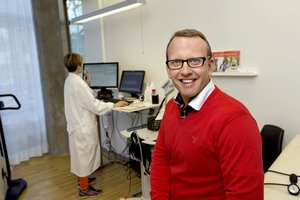Why We Need Smarter IT (Not More IT) in Healthcare
Henric Carlsson, CEO of Conscriptor, on Time-wasters, IT systems & Real-life Work Practices in Healthcare

Henric Carlsson has extensive experience of both clinical healthcare and the pharmaceutical industry. Today, Henric is CEO of Conscriptor, a company that offers support services for managing medical records by providing both on-site temp staff and remote staff. In parallel with his role as head of Conscriptor, Henric is also involved in a large number of projects that aim to trial the patient-oriented approach to administration that is set to shape healthcare’s future.
The Paradox in Sweden’s Healthcare System
Henric describes what he sees as a paradox within Sweden’s current healthcare system: although the country has never had so many qualified doctors and nurses, waiting times, healthcare staff’s feelings of professional inadequacy and their leaves of absence due to illness are all on the rise.
“Over the years, I’ve had an untold number of discussions with doctors and nurses. One subject constantly raised in these conversations is what medical staff perceive to be the inordinate amount of administrative work required of them. Many feel that their administrative load doesn’t leave them enough time over to do what they’re really passionate about – clinical work. That is, taking care of patients and delivering good-quality healthcare,” Henric relates.
Today’s IT Solutions an Obstacle to Efficiency
In Henric’s opinion, the key to working both smarter and more efficiently lies in reviewing what systems are in place for supporting IT in healthcare and how work is actually carried out. He explains:
“Through various projects, we’ve taken a closer look at how work is carried out at a large number of local healthcare centres in Sweden. We discovered that one very obvious time-waster is the log-in process used. Nowadays, most healthcare environments require staff to log in to a host of different systems before they can access the applications and data they need to do their jobs. As such, there are major opportunities for streamlining in connection with log-in procedures.”

Double Registration a Time-waster
Another common time-waster is registering the same patient data and other information separately in a number of different support systems. The need to manually enter the same information in multiple locations is often felt to be both unnecessary and tiresome, especially when it is first recorded on paper and then needs to be recorded all over again on a computer, Henric explains.
“A lot of time can be saved even in the initial patient data-registration phase. One way to streamline this process is to leverage mobile solutions for entering patient information together with the patient. You can even encourage patients to submit more of their data independently and to describe the symptoms and health problems they’re experiencing directly via their smartphone or tablet,” says Henric.
New Patient Journal Systems No Cure-all
Outdated healthcare and medical records systems are often singled out as the culprits behind administration that is costly in terms of both time and money. In addition, according to Henric, the level of user-friendliness varies greatly among different suppliers’ systems. In some environments, this can result in 20-25 per cent more time needed to log in and carry out work, for example. On the other hand, Henric acknowledges that replacing healthcare’s current IT solutions with new versions is only part of the solution. He explains:
“Newer, more modern records systems would definitely be a step towards achieving smoother administration. That said, transitioning to a new system can cost in the vicinity of 1 billion Swedish kronor (EUR 97 million) and, in the worst-case scenario, also take years to complete. Anyone planning to attempt this kind of project needs to ask themselves whether a new, more modern records system really is the only solution, especially given that many users don’t make full use of their current solutions. Above all, it’s important to have a clear plan in place for leveraging the improvements on offer. Otherwise, this kind of implementation project risks becoming just another drain on resources.”
The Answer Lies in the Numbers
If we are truly going to succeed in rooting out time-wasters, we must first identify and understand them and then draw up an action plan based on this knowledge, Henric believes. He describes how Conscriptor has increased productivity in its own documentation work by 40-50 per cent by effectively integrating its different systems, thereby saving time and reducing worker frustration.
“At Conscriptor, we take an agile approach by continually evaluating, improving and simplifying our work flows to increase our efficiency. For the most part, it comes down to analysing our existing data. As soon as we detect patterns and recurring behaviours, we know that, in all likelihood, there’s a chance to improve our efficiency. I’m convinced that IT in healthcare’s development will increasingly boil down to the ability to manage big data and to make the best use of it,” says Henric.
AI an Ally in the Fight against Time-wasters
Looking ahead, Henric believes that AI will help us draw even greater benefit from existing data in the fight to eradicate many of today’s time-wasters. Currently, new technological solutions are in use within eHealth that streamline administration work via voice-recognition capabilities and the ability to convert speech directly to a journal entry in written form. In the future, we can look forward to receiving recommendations on the right course of treatment directly from medical staff’s dictated notes, based on the statistical analysis of pre-existing data.
Leadership & the Will to Progress Equally Important
“Still, there’s a risk in bandying about new jargon like ‘digitalisation’, ‘artificial intelligence’ and ‘big data’, believing that these will solve healthcare’s problems by themselves. I’m convinced that finding new solutions for IT in healthcare is only half the answer when it comes to improving efficiency. The other half lies in ‘softer’ factors like leadership and the desire to make progress. In Sweden, the healthcare system is tax payer-funded. In my eyes, this means that we who provide healthcare services have a much bigger responsibility than simply taking care of our bottom line. We also have a fundamental social responsibility to make healthcare better,” Henric concludes.
